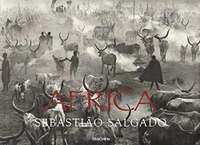Klappentext
Sebastiao Salgado is one the most respected photojournalists working today, his reputation forged by decades of dedication and powerful black and white images of dispossessed and distressed people taken in places where most wouldn't dare to go. Although he has photographed throughout South America and around the globe, his work most heavily concentrates on Africa, where he has shot more than 40 reportage works over a period of 30 years. From the Dinka tribes in Sudan and the Himba in Namibia to gorillas and volcanoes in the lakes region to displaced peoples throughout the continent, Salgado shows us all facets of African life today. Whether he's documenting refugees or vast landscapes, Salgado knows exactly how to grab the essence of a moment so that when one sees his images one is involuntarily drawn into them. His images teach us the disastrous effects of war, poverty, disease, and hostile climatic conditions.
This book brings together Salgado's photos of Africa in three parts. The first concentrates on the southern part of the continent (Mozambique, Malawi, Angola, Zimbabwe, South Africa, Namibia), the second on the Great Lakes region (Congo, Rwanda, Burundi, Uganda, Tanzania, Kenya), and the third on the Sub-Saharan region (Burkina Faso, Mali, Sudan, Somalia, Chad, Mauritania, Senegal, Ethiopia). Texts are provided by renowned Mozambique novelist Mia Couto, who describes how today's Africa reflects the effects of colonization as well as the consequences of economic, social, and environmental crises.
This book brings together Salgado's photos of Africa in three parts. The first concentrates on the southern part of the continent (Mozambique, Malawi, Angola, Zimbabwe, South Africa, Namibia), the second on the Great Lakes region (Congo, Rwanda, Burundi, Uganda, Tanzania, Kenya), and the third on the Sub-Saharan region (Burkina Faso, Mali, Sudan, Somalia, Chad, Mauritania, Senegal, Ethiopia). Texts are provided by renowned Mozambique novelist Mia Couto, who describes how today's Africa reflects the effects of colonization as well as the consequences of economic, social, and environmental crises.
Rezensionsnotiz zu Süddeutsche Zeitung, 20.11.2007
Zwiespältig wirkt Sebastiao Salgados opulenter Band mit Fotografien Afrikas auf Rezensentin Sonja Zekri. Die Bilder des brasilianischen Fotografen, der Afrika seit über 30 Jahren bereist, zeigen in ihren Augen ein geradezu erschreckendes Leiden, aber auch überirdische Schönheit. Sie gewinnt den Eindruck, bei Salgado würden die Grenzen von Kriegen und Ländern verschwimmen und die Zeit still stehen. Dabei attestiert sie dem Fotografen, an vergessene Konflikte zu erinnern und Szenen vor Augen führen, die niemand sehen möchte. Problematisch erscheint Zekri allerdings die Ästhetik, derer sich Salgado bedient, um den Schrecken abzulichten: er schaffe "Ikonografien des Hungers, des Kriegs, des Todes" und zeige geradezu "biblische Figuren", die ihr Schicksal demütig hinnehmen.
Lesen Sie die Rezension bei
buecher.deThemengebiete
Kommentieren










